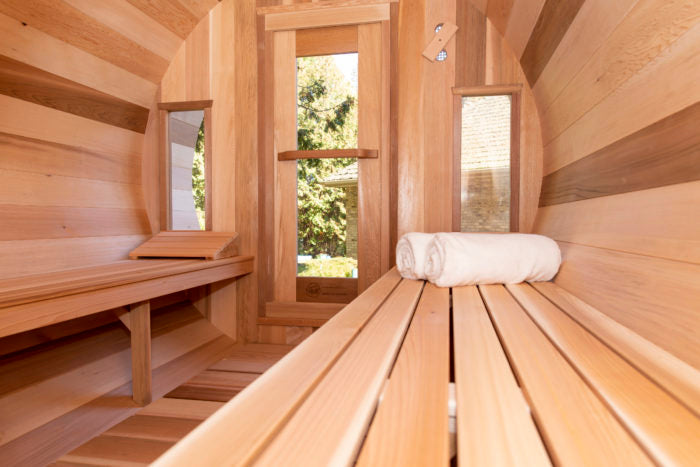Traditional Sauna - Questions
Traditional Sauna - Questions
Blog Article
Rumored Buzz on Traditional Sauna
Table of ContentsSome Known Details About Traditional Sauna What Does Traditional Sauna Do?Unknown Facts About Traditional SaunaAll About Traditional SaunaTraditional Sauna - Truths
Most of the weight lost in a sauna is water loss and is re-gained upon rehydrating. Without a question sauna can be a vital component of a healthy weight loss program. To check out the distinctions in between traditional and IR saunas, I will certainly divide these into proven, theoretical, and produced distinctions.Thus, the most popular factor in the saunawhich is at the ceiling directly over the sauna heateris generally in between 185 and 190 F. Claims that a standard sauna exceeds 200 F is merely not true and not appropriate for electric saunas sold in the United States. The temperature level for a far-infrared sauna is typically established in between 120 and 140 F; nevertheless, unlike the typical sauna, the objective in and IR area is not to attain a high temperature.

When a standard sauna has actually been properly heated, the sauna walls are warm, the air temperature level has actually achieved set temperature level and the rocks are incredibly heated. As a fascinating side note, the heated wall surfaces and the rocks are releasing far-infrared warm, incorporated with the heated air, to produce an "wrapping up warm".
3 Easy Facts About Traditional Sauna Described
When the high temperature is attained, the aspects cycle on and off to keep the high temperature level. Most typical sauna customers delight in putting water over the rocks to produce vapor to elevate sauna humidity degrees. The advantages of pouring water over the rocks consist of: making the area extra comfy, dampening the nasal flows, and allowing the usage of aromatherapy by blending necessary oils with the water.

When the energy goes into the body, it causes the body temperature to raise and eventually results in sweating. In an infrared sauna it is essential for the emitters/heaters to remain on virtually constantly. Considering that there is no mass of rocks to maintain warm, the sauna will certainly cool if the emitters closed off.
All about Traditional Sauna
As pointed out over, the sauna bather in an infrared space wishes to position himself before operating emitters to obtain optimal gain from the warm. The heating time for both rooms can be very various, relying on just how the areas are made use of. For a conventional sauna, a bather should allow 30-40 minutes for the area to accomplish a desired temperature level and to correctly pre-heat the rocks.

A well built sauna will generally attain a temperature level of 150-160 F in regarding 30-40 mins (Traditional Sauna). For hotter temperatures, the room may require to warm for a longer duration. When the room attains established temperature, the heating system will cycle on and off, generally running about 50% of the time. The shielded walls and the warmed rocks will keep the space hot and at stable temperatures.
To some, 15 mins was "wasted" while the infrared energy heated the timber panels instead of heating a body, while others locate a pre-heated area to be a lot more comfortable and believe an elevated starting temperature level is required to start sweating. The size more helpful hints of advised use for each and every area is approximately the exact same (10-15 minutes per session); nevertheless, due to the reduced air temperatures and the ability to feel the effects of infrared warm faster than a conventional imp source sauna, it is not unusual for an individual to spend an overall of 20-30 mins in an infrared sauna.
Traditional Sauna Fundamentals Explained

The average cost per kWH of electrical energy in the U.S. is about $0.11, so a 4.5 kW heating system will certainly set you back around $.50 to compete one hour, if the heating unit runs continually for one hour. Typically a sauna heater will certainly run for 75% of the first hour and 50% of subsequent hours on because the components cycle once the set temperature is attained.
A two individual far-infrared area is typically physically smaller than a conventional sauna, frequently concerning 4' x 4' or smaller sized. The IR heating system is usually 1.5-1.7 kW using a 120 volt 15 amp plug-in service. Because the space can be made useful reference use of sooner than a sauna space, we will certainly presume the space is utilized for to of an hour consisting of warm up time.
There is a seldom discussed difference in the social experience in between the two areas. While our culture has actually lost some of the social benefit of the traditional sauna experience, it can be extremely socially satisfying (Traditional Sauna). From family time in the sauna, to heart-felt discussions with better halves, to sauna partiesthe standard sauna experience can result in intimate mingling
Traditional Sauna - An Overview
Most higher end infrared spaces consist of tinted light therapy, noise systems and full-glass fronts.
Report this page